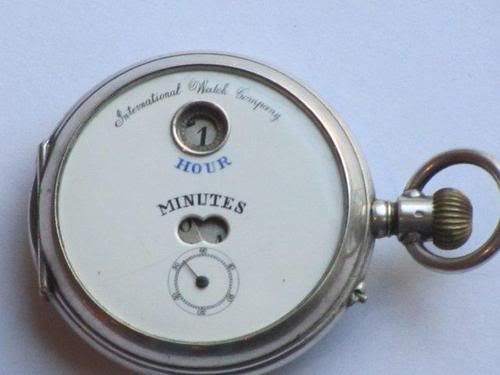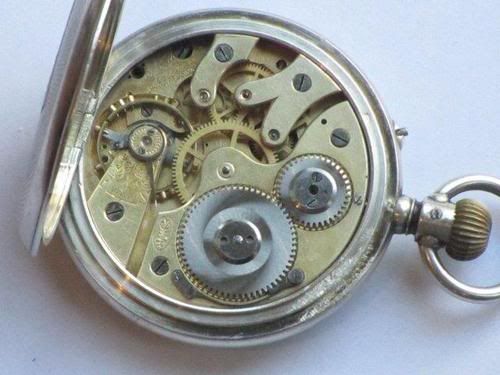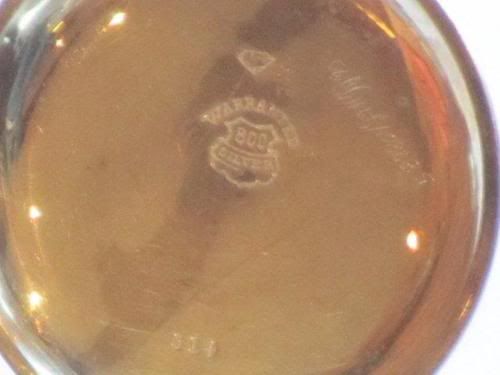After several years of searching, I've finally found and added a circa 1884 Pallweber I, calibre 40 to my pocket watch collection.
The number of the movement is 554. Someone knows one with a lower number?
Pallweber nr. 554
- 101 replies
- last reply by sefru 16 May 2012
-
Connoisseur
-
Connoisseur
I'm sorry I cannot upload photos. Can anyone tell me how do it?
-
Master
Here's how to post a picture.

-
Connoisseur
Thank you Bill!



-
Connoisseur
What, may I ask, is the movement number?
-
Connoisseur
Movement number is 554! Someone knows one with a lower number?
-
Insider
Congratulation!
Obviously you have a very early Pallweber II watch (c.41). The new numbering started in the IWC registers on January 1885 with No. 6501, a Pallweber II calibre. -
Connoisseur
Exactly --what an interesting watch, but the numbering does raise an issue. No Pallwebers could have produced under the first numbering or, if they did, the numbers would at least be higher than, say, 25,000. But if the second numbering starts at 6501, how could this number be so much lower?
Either the watch is wrong or the standard knowledge about the early numbers of the second numbering is wrong. There's nothing wrong with this beautiful example, at least that I can discern, so I submit the idea that the second numbering started at 6501 must be wrong.
Interesting indeed.
-
Connoisseur
I wrote David Seyffer, the Museum curator, and received this reply (slightly edited):
[b]
"I also paid attention to this thread. Very interesting indeed. I never saw a Pallweber numbered according to the 1st numbering system. But never say never."In the IWC collection we have a Pallweber I with the number 350. I date that movement to July 1884. So 554 must have been made in July or August 1884.
"The second numbering system started with 1 (due to my studies of July 1884). The only Problem is that the records before 6500 are lost. Remember the Elgin I Nr. 22 and 33? There is a lot of evidence that watches with numbers under 6500 according to the 2nd numbering system exist."[/b]
I very much appreciate this information, as I'm sure other IWC historical buffs do.
-
Master
Very interesting thread. The Pallweber is one of the most unusual pocket watches in my opinion. It is a relatively simple movement that foreshadowed the digital age.
If we could only convince IWC to make a properly priced Zeitwerk...... -
Master
many thanks to Costi92, Michael and David for this - very useful to know.
-
Master
+1. I concur whole heartedly with the last sentence.
-
Master
Fantastic watch there costi92 !
It's amazing how we continue to learn more and more about these early pieces.
MF, was this movement cased in the US?
Best regards
Mark -
Connoisseur
Let's go in order, one problem at a time.
1) The case is certainly Swiss as evidenced by the grouse hallmark.
2) I think David Seyffer is right when he thinks that there are no Pallwebers that belong to the first numbering system.
3) The watch nr. 554 belongs to the second numbering system that began moving from number 1. Simply to the number 6500 there is no documentation in the archives.
4) I believe that through the evidence of watches still in existence the nn. 1-300 of second numbering were all Elgin I (are known to me n. 22 caliber 32, n. 33 caliber 33, n. 86 caliber 32, n. 148 caliber 32, n. 230 caliber 34, n. 256 caliber 34). Probably the nn. 301-600 were Elgin II, Pallweber I (also the n. 331 is a Pallweber I). After there is another tranche of Elgin I (I know n. 614 caliber 32, n. 616 caliber 34, n. 824 caliber 32).
5) To the best of my knowledge the first Pallweber II (cal. 41) still in existence has the movement number 1579.
So the watch in question belongs, as I belive, to the first tranche of Pallwebers, perhaps the only one of Pallwebers I (cal. 40).
-
Apprentice
Dear Costi92,
Thank you very much for the summery.
The only way to "reconstruct" the batches of the 2nd numbering system / numbers below 6500 is to collect all the information about existing watches with numbers below 6500.There is a Pallweber II movement in the IWC collection with the number 979. It might be a prototype because it remained in our collection for so many years and never had been incased.
I know from letters of Johannes Rauschenbach - still existing at IWC corporate archives - that IWC in 1884 was trying to improve the Pallweber mechanism. There was a continuous improvement process going on in 1884/85. So IWC changed promptly after the introduction of the Pallweber I to Pallweber II.I really do not know how many Pallweber I still existing. Therefore I really appreciate if we can detect existing movements or watches and most of all if forum members present their antique IWC watches here in the forum. Thank you so much for sharing.
Best wishes from rainy and cold Schaffhausen,
David Seyffer
Museum Curator -
Master
Terrific find. Congratulations.
-
Master
+1!!!
-
Master